From January to July, a total of 430,000 vehicles were imported and 516,000 were sold, down 30.1 percent and 20.8 percent year-on-year respectively. In July, 69,000 cars were imported and 85,000 were sold, down 12.7% and 3.4%, respectively, from a year earlier.
Mr. Wang said that while imported car data had recovered, the overall market was still not growing at a rapid pace. Among them, the proportion of parallel imported cars reached a record high in June, but it was mainly due to the "window period" caused by the switch between China and Six countries. "There will be no more such a large quantity in the future".
On September 1, The China Association of Automobile Dealers released the Monthly report of China's imported automobile market for July 2020. Benefiting from the slowdown in the global epidemic situation, China imported a total of 69,000 vehicles (including chassis) in July, down 12.7% year on year, with the import value of 22.87 billion yuan. In the same month, the sales volume of imported passenger car terminals was 85,000 units, down 3.4% from the same period last year, with the decline narrowing rapidly.
In the first seven months of this year, a total of 430,000 cars were imported, down 30.1 percent year-on-year, and the import value was 142.80 billion yuan. During the same period, imported passenger vehicle terminal sales of 516,000 units, a year-on-year decline of 20.8 percent.
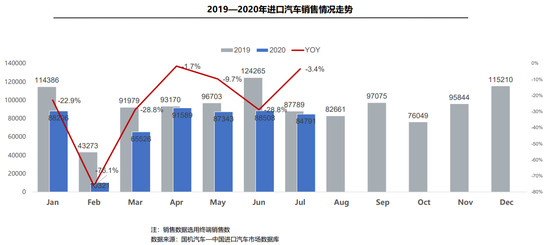
In response, Wang Cun, director of the import vehicle Committee of the China Association of Automobile Dealers, said that the decline in the import vehicle data was mainly due to the low base caused by the switch between the five and six countries in the same period last year. So while the Numbers are recovering, the overall market is still not growing at a rapid pace.
It is worth mentioning that from January to June, there were 57,000 parallel imported cars in China, accounting for 15.8% of the total, an increase of 0.8 percentage points compared with 2019. But Mr Wang said bluntly: "This is a record high [but] there won't be any more of this."
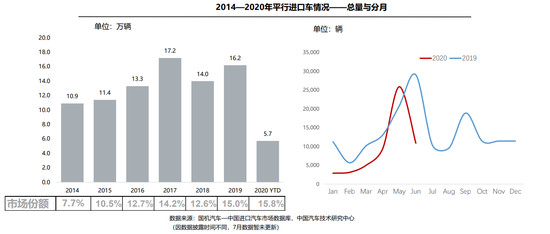
Wang further analyzed that last year's 5-6 standard switch caused car manufacturers to rush to import large quantities of cars before the June window period, and this year still faces the same problem. Due to the implementation of the six standard time delay from July 1, 2020 on January 1, 2021, so in the early implementation of the six part is not standard, by 30 June import countries five vehicles can still sell, the dealer to parallel imports created another window, it is also a parallel imports in June even from plunged 57.9% to 10900 vehicles, but its market share is still continue to go up. However, as the window faded, parallel imports came to a near standstill in July, with sales down 18.6 per cent year-on-year to just 10, 000 units.
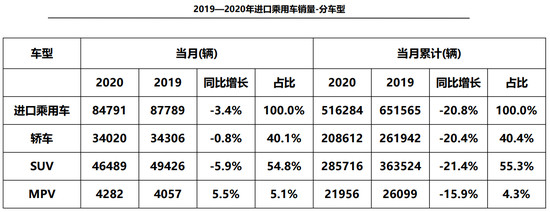
Specifically, in the first July, imported passenger car models were still dominated by cars and SUVs, accounting for 95.7%. Sedans, SUVs and MPVS declined by 20.4%, 21.4% and 15.9%, respectively. In July, the decline in sedans and SUVs eased to 0.8 percent and 5.9 percent, respectively, while MPV rose 5.5 percent. In addition, According to Wang Cun, the market structure data of imported cars show that the epidemic has a relatively small impact on the middle and high-end market. The impact of the epidemic on consumers with different incomes is different. For consumers with low and middle incomes, the impact is obviously greater than that of those with high incomes:
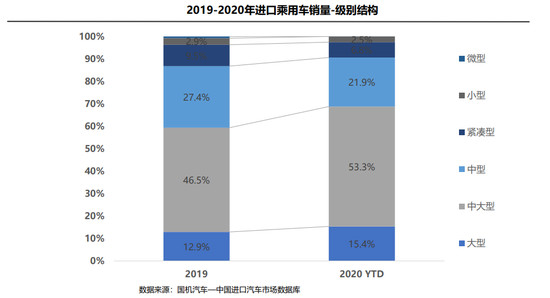
From the level perspective, from January to July, the market segment share of large and medium and large imported vehicles increased by 2.5% and 6.9% compared with 2019, respectively, while the market share of other market segments decreased. From January to July, luxury brands accounted for 79.1 percent of total sales, while non-luxury, luxury and ultra-luxury brands fell 33.9 percent, 16.6 percent and 8.6 percent, respectively. In the first July, the pattern of imported brands changed slightly. Lexus was still in the first place, but Mercedes overtook BMW in the second place. Among the top 10 brands, Lexus expanded at 8 per cent, while Mercedes reversed its decline and the rest remained in decline.
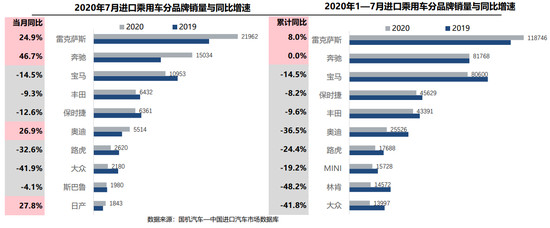
Similarly, in terms of displacement, the proportion of imported cars representing the 2.0-3.0-liter displacement range of the middle and high end is further expanded, and the overall share is over 40%, increasing by 9 percentage points over 2019. Although 1.5-2.0 liter is still the first displacement range, accounting for 43.1%, the share has decreased by 3.1 percentage points. In addition, the share of the sub-1.0 liter engine segment also fell by nearly 3.8 percent, but this was mainly due to the decline in sales of imported new-energy vehicles after Tesla's domestic production.
AMS2024 Exhibition Guide | Comprehensive Exhibition Guide, Don't Miss the Exciting Events Online and Offline
Notice on Holding the Rui'an Promotion Conference for the 2025 China (Rui'an) International Automobile and Motorcycle Parts Exhibition
On September 5th, we invite you to join us at the Wenzhou Auto Parts Exhibition on a journey to trace the origin of the Auto Parts City, as per the invitation from the purchaser!
Hot Booking | AAPEX 2024- Professional Exhibition Channel for Entering the North American Auto Parts Market
The wind is just right, Qianchuan Hui! Looking forward to working with you at the 2024 Wenzhou Auto Parts Exhibition and composing a new chapter!
Live up to Shaohua | Wenzhou Auto Parts Exhibition, these wonderful moments are worth remembering!
Free support line!
Email Support!
Working Days/Hours!





